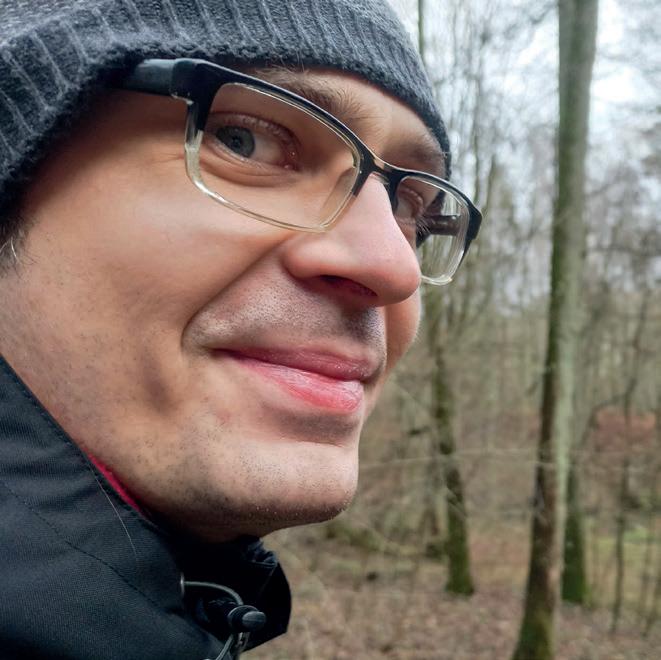
11 minute read
The Brazilian-Bolivian borderland closed in a glass (part 2) – Kamil Hazy

Kamil HAZY
Advertisement
A biotope aquarist with experience in international competitions. Advocate of systematization of environmental aquaristics. Organizer – together with ”Aquarium Magazine” – of the Polish Biotope Contest. He offers services of consulting and arrangement of biotope, habitat and environmental aquariums. He believes that aquaria are primarily intended to meet the needs of their inhabitants.
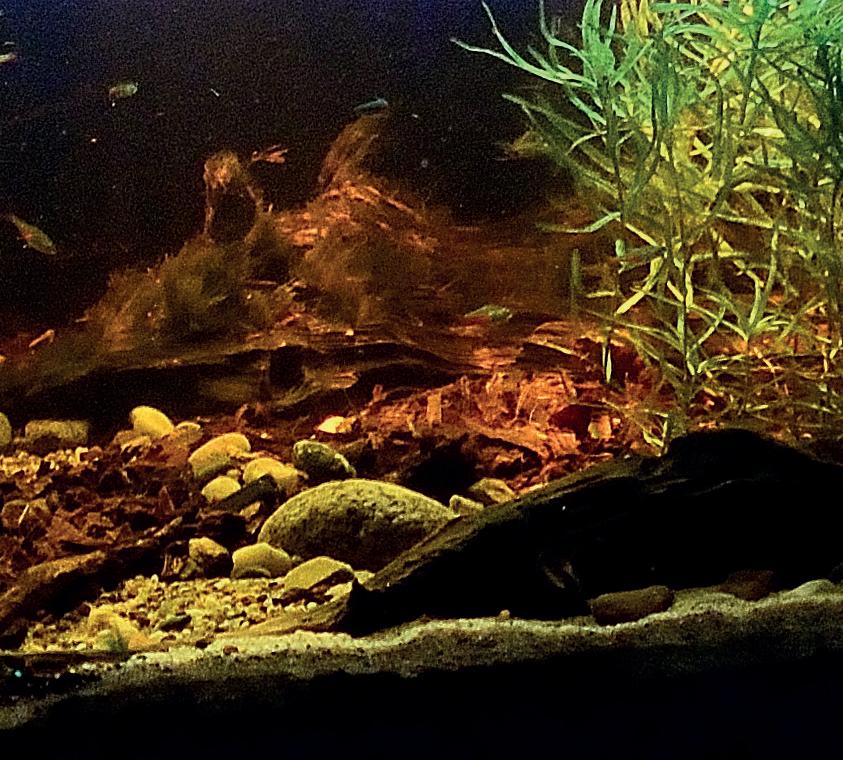
THE BRAZILIAN-BOLIVIAN BORDERLAND CLOSED IN A GLAS
My first biotope story (part 2)
I remember my first aquarium as clearly as if I had started it yesterday... I guess each experienced aquarium hobbyist could start their story this way. Most of us, especially at the beginning of our adventure, are looking for ideas in one moment, and end up with several tanks at home in another. The longer you are in this hobby, the harder it is to find limits.

BADC 2018 competition arrangement – Guapore River floodplain
The start of the new project was born after the complete remodeling of the concept concerning inanimate matter in the aquarium. I was now focused on flooded meadow lying on the Bolivian side of the Rio Itenez... The arrangement in the tank was to depict the exposed, shallow root of a nearby tree, around which Helanthium bolivianum ”Angustifolius” grows luxuriantly. So I took all the wood out of the tank (it occupied a capacity of several dozen liters) and decided to get a new root, chosen specifically for this arrangement. FREE EXPANSION The beauty of this tank, its transformation, stabilization and fish behavior gave me enormous joy for months. Towards the end of its existence I experimented a bit with planting and deliberately remodeled the ecosystem to watch the sometimes surprising results. To those who want to understand how expansive plants can be and how they can completely change a habitat, I recommend introducing such a plant to your tank and allowing it to develop completely freely. I used a popular Pistia (Pistia stratiotes) and let it spread over Helanthium bolivianum. It only took
Tank during rearrangement period, winter 2018
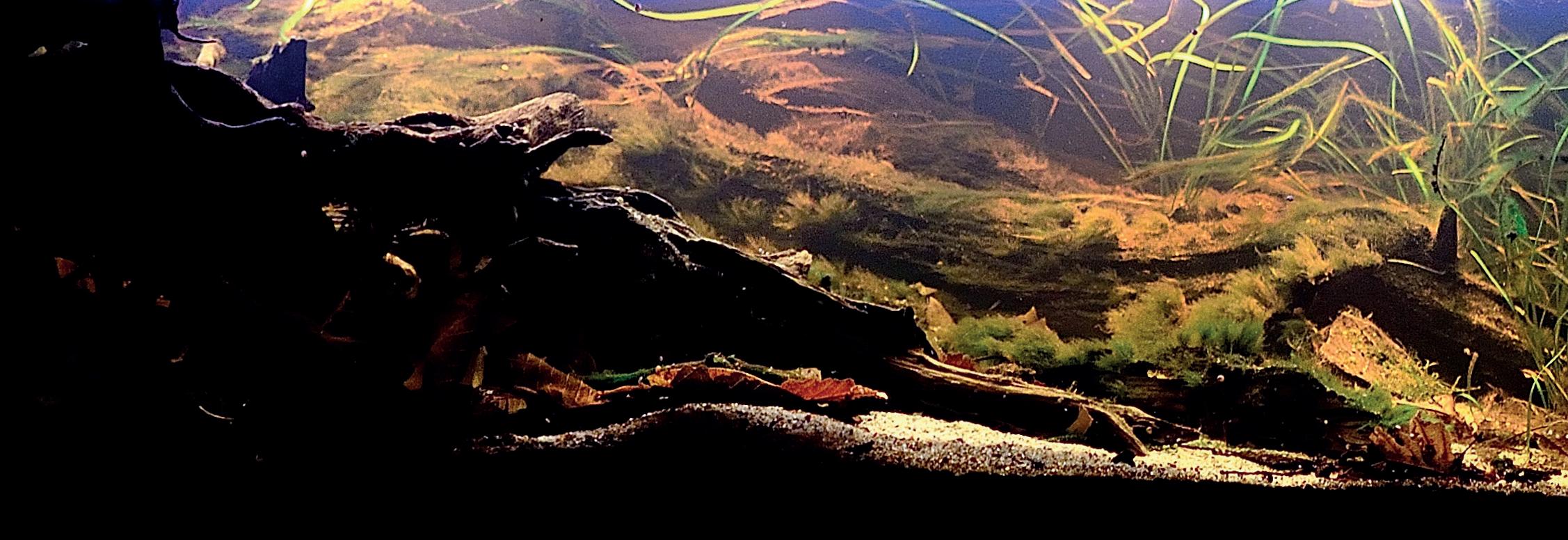
a few weeks for the reservoir to take on a completely different character, which in nature would most likely attract different species of fish to this place than those that existed here before. I like observing these stages of change because of two aspects. The first is the ”wildness” and ”dynamism” of the tank and the other
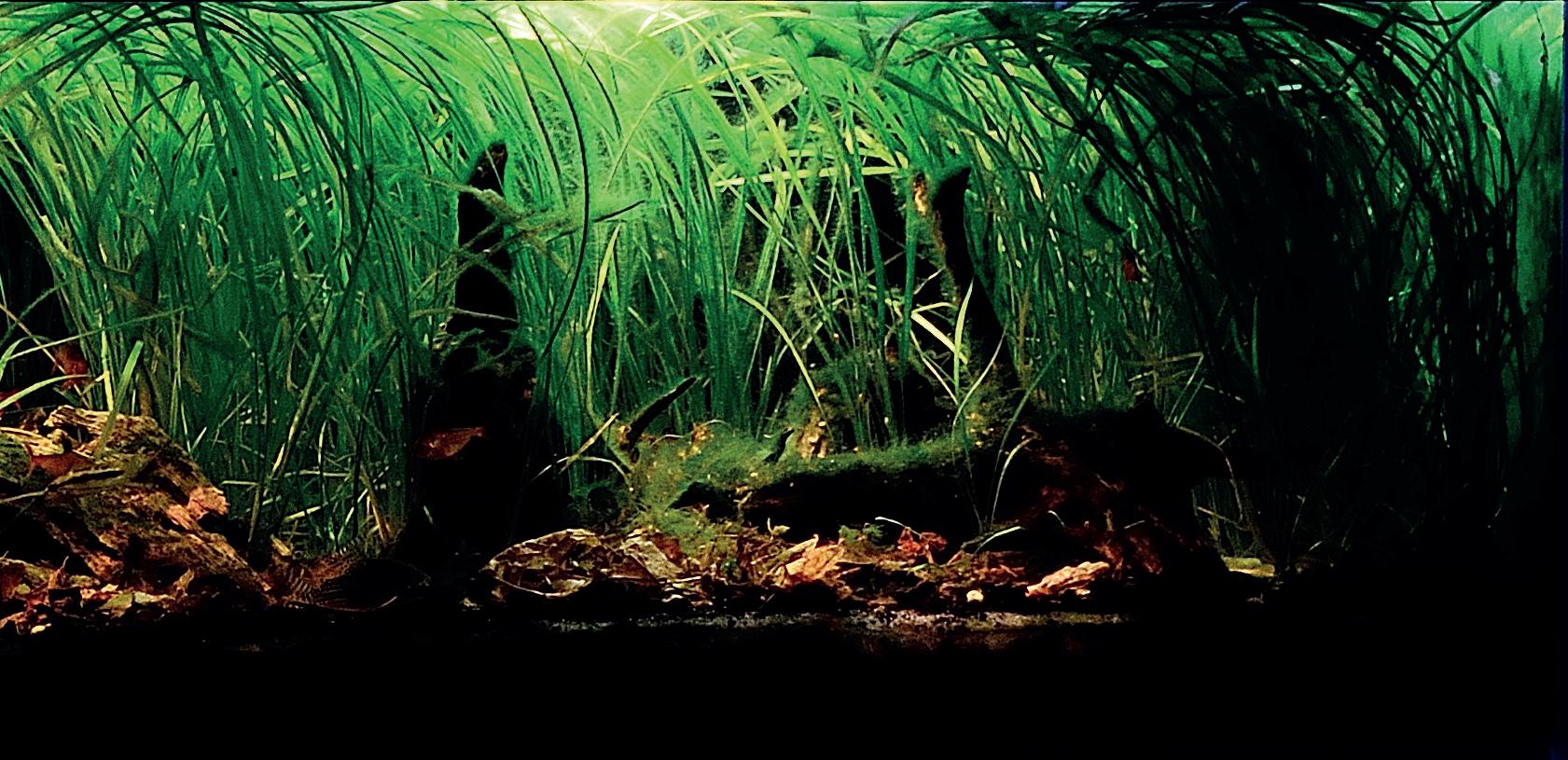
a chance to take the greatest photos of Apistogramma trifasciata I’ve been able to take in all my several years of adventure with these fish. Of course during the expansion of the floating plant I made some adjustments to the hardscape, but these were not interferences that completely changed the nature of the tank. After a period of dynamic changes caused by the wilderness of the ecosystem, I decided to tidy up the concept a bit and see how other, and new to me, plant species would cope. All this with the intention for a greater change that was soon to come. Driven by nostalgia for my first ”root arrangement”, I thought back to the Noel Kempff Mercado National Park, located on the Bolivian side of Rio Itenez, specifically in the area of one of the river’s tributaries: Rio Paragua. As an idea for the arrangement I used a habitat corresponding to a small forest stream flowing into the mentioned river. The stream was rolling tannin-rich waters, but near its right bank the incident light gave a clump of Eichhornia diversifolia a chance to thrive. For the first time I used exposed pebbles in my arrangement. The animal stock in the aquarium has also changed. I said goodbye to a large group of Hyphessobrycon eques, and in their place I purchased Aphyocharax rathbuni and, a little later, Hyphessobrycon herbertaxelrodi. Also Hydrocotyle leucocephala returned to my tank. As before it was supposed to create an interesting looking overwater part.
A DIGRESSION ON TRANSITIONAL ENVIRONMENTS This is a good moment to make a brief digression, as in the previous part of the article. With time, as my knowledge and aquaristic experience developed, I became dangerously attracted to the specifics of transitional ecosystems, i.e. zones where water meets air. I mean all coastal areas, periodically flooded meadows or watercourses with fluctuating water levels. This is because the adaptation processes of plants and animals to the environment that changes over time are much more interesting to observe than a permanently flooded water habitat. Simulating the dry and rainy seasons in a tank is an interesting experience that


Tank during rearrangement period, winter 2018
I recommend hobbyists to try on their own, because the conclusions will give any keen nature observer a lot to think about. Learning about the defense mechanisms of fish (changed way of feeding, staying in other parts of the tank, etc.) and plants (changes in leaf structure, dying out of the mother plant in favor of offspring plants, etc.), as well as noticing the impact of changes on the reproductive cycle of organisms gives a complex insight into life processes and a chance for very satisfactory observations. My arrangements are increasingly moving towards depicting these transitional zones. Of course, I encounter new challenges and problems along the way, mainly in the availability of plants from restored habitats. Here I have to mention one of the rules of biotope aquaristics, which says that the planting density of the tank should closely reflect the nature. When creating transition zones, however, it quickly becomes apparent that the availability of ”biotopically correct” plants is very difficult. One approach, which I recommend to any aquarist, is to use commercially available plants that look almost exactly like ”biotope correct” plants. Related species, growing in the same region of the world and similar habitats, are after all used by many aquarists as substitutes for the originals. If the differences in the structure of the plant and in the way it grows or affects the ecosystem are, in principle, minor, then they can be easily accepted. Although I prefer to call a reservoir created in this way a habitat reservoir, instead of a biotope, it does not absolutely undermine its value, and in this case I am not offended by the use of a name that is not entirely correct.
BIOTOPE AESTHETICS I have to admit that with time I have more humility in me. These days, my perspective on aquariums is starting to get a little broader. After all, I’m not just talking about biotope aquariums anymore, but I’m focusing on the whole issue of environmental aquariums as a resultant of biotope, habitat and area tanks (as well as others related to them and less popular).
BADC 2019 competition arrangement – a small tributary of the Rio Paragua, Bolivia

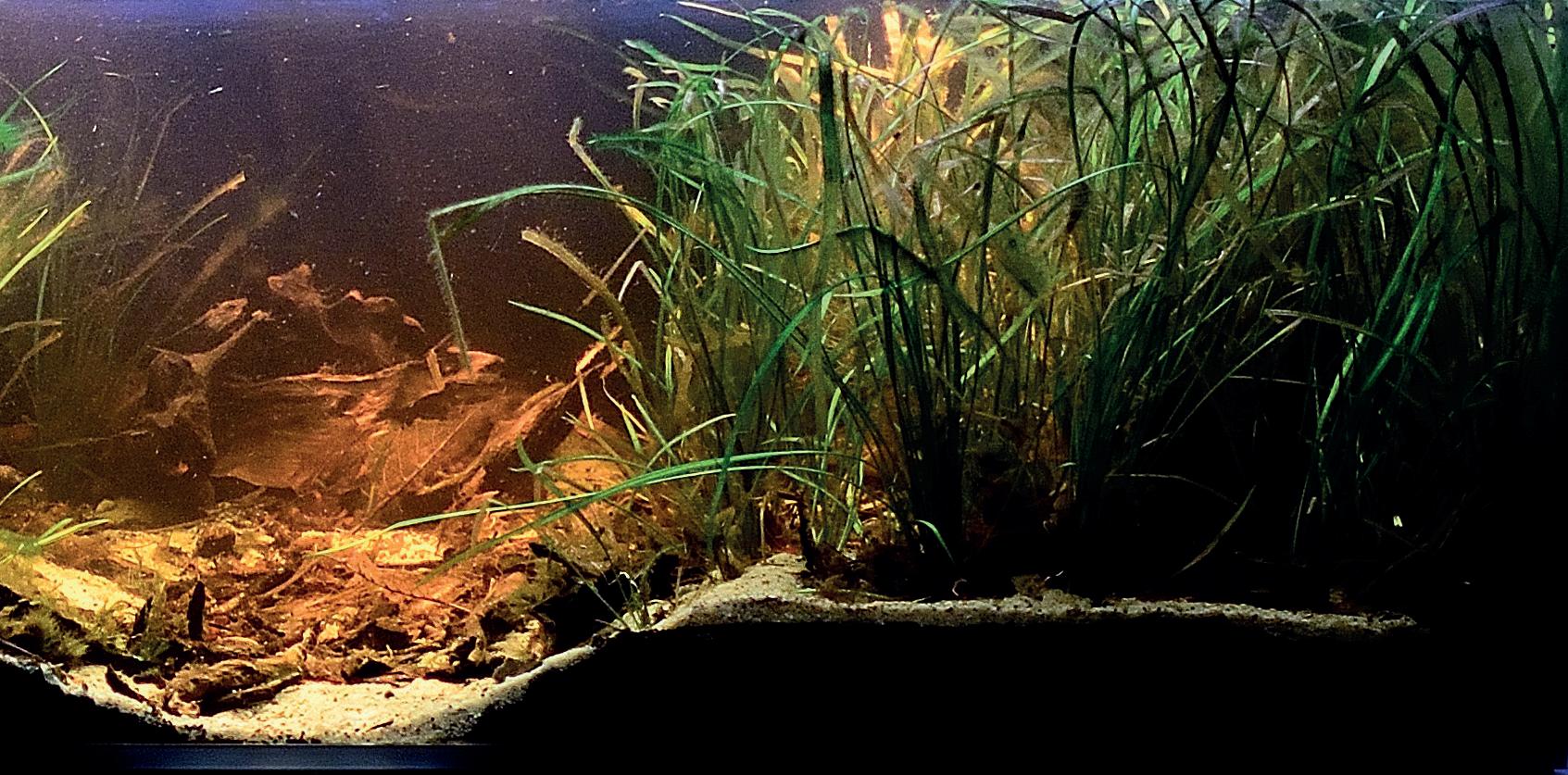
Additionally, at this point I must give due credit to the best aquarium artists who arrange nature style aquariums. Certain techniques, which they introduced to aquaristics and refined over the years, developed certain habits in their audience and tendencies to search for the universal canon of beauty. Today, all over the world, this „aesthetic” direction is visible in the development of works in competitions for the arrangement of biotope tanks. Thanks to applying techniques learned from others, many biotope aquarists, including myself, have improved their skills and more proficiently focus the attention of the viewer, who is not an expert in most cases. I believe that the greater influence of arrangement techniques can be a positive contribution to the development of environmental aquaristics.
PRIORITIES However, do not think I’m changing my mind very easily. After all, I have always claimed that aquascaping cannot be completely compatible with biotope aquaristics because the latter simply has different goals. This is still true today and does not conflict with the use of solutions that allow a better visual perception of the tank and at the same time do not worsen the living conditions of the animals. Of course I do not approve of creating tanks only for the sake of calling them ”biotope tanks”, in which the only emphasis is placed on the arrangement, and the aspect of longterm functioning of the tank is totally ignored. Unfortunately, aquaria set up only for competitions, for a single photo or a film, are often a desert in terms of biodiversity (completely fresh, with no trace of uncontrolled 100% influence of natural processes) or so overloaded with decaying organic matter that maintaining biological stability in them is nearly impossible. They are undoubtedly beautiful and often faithfully represent the biotope at a precise moment of the year, but – losing the sense of stability in biodiversity – they are much further away from biotope aquaristics than many of us might think. And yet the most important principle of all environmental aquaristics is the well-being of the organisms inhabiting the tanks and that’s what the emphasis should be put on. But let’s let aquarists decide themselves which approach to showing biotopes is ultimately more appropriate. Let them do it according to their own conscience and preferably after trying to run the tank in both ways for a while.
FINAL ARRANGEMENT The next step in my journey of finding a perfect arrangement was to try to combine three habitat sec-


Arrangement in early 2020
tions into one biotope. Such a diverse ecosystem was to include plants that were flooded for a very short period of the year but rooted in wet substrate, plants that were periodically exposed and flooded, and plants that were flooded most of the year. I approached the creation of the final arrangement gradually, after all I was working on a living ecosystem as usual. The transition zone of the reservoir received a typically emersive plant, which tolerates short-term flooding very well, and grows well with roots submerged in water or flooded substrate. I’m talking about Spathiphyllum sp. Unfortunately, it is impossible to determine a specific species, and commercially available plants are already mostly farmed specimens, often possessing selected traits, so I must humbly accept that I have condemned myself to the previously described inaccuracy and my tank has become more of a habitat one. The plant in the first stage of my adventure landed on top of the ”rooting area” and it was inserted between the shoots of a luxuriantly growing Hydrocotyle leucocephala. I lowered the water level in the tank by few centimeters to be able to simulate dry and rainy season better. The right side of the tank was elevated to accommodate future low plants to create something like the ”carpet grass” so popular

Evolution of the 2020 arrangement – Las Torres stream bank in the Rio Guapore basin, Bolivia

in planted aquariums. After a few months of gaining experience and watching carefully the changes taking place, I made the final moves in my first aquarium adventure. I remodeled the left side of the tank. I created peculiar ″islands” (″pots” made of pebbles and small roots covered with substrate) for Spathiphyllum sp., shaped the substrate accordingly and to this day I’m still enjoying an arrangement showing the bank of the Las Torres stream in Bolivia, to be more precise, a place where its two branches join. The arrangement will be the last change that I am combining with my exploration of the Pantanal area and the Rio Guapore basin. So inevitably the time for testing new solutions is approaching. And I will certainly try them in the future. The fish I have are mostly aged now, so I’m gonna wait until they go away, and then I’m going to turn to completely different parts of the world. Where exactly? I honestly don’t know. I have a few biotopes which I find appealing, but I’m sure of one thing: I’ll be focusing on replicating the transition zones as closely as possible. Of course, such an approach will lead me towards thorough understanding of the nature of biodiversity in time-varying ecosystems.
That’s the story for the next few years. My agreement with my wife regarding the number of aquariums is in effect and I have to admit that it works for me as well. I enjoy the bond with nature, I have wonderful experiences, and at the same time I don’t spend all my free time maintaining the aquariums. I now can spend it on sharing my own perspective on environmental aquariums with others. See you on the pages of Tropical EDU Magazine and on the Tropical EDU channel on YouTube. Keep on biotoping!

